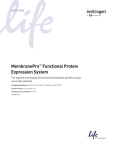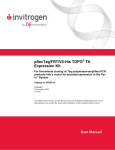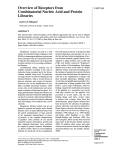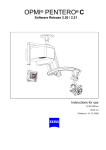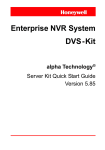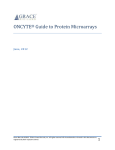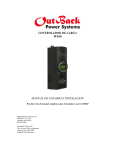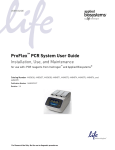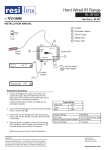Download TOPO - Thermo Fisher Scientific
Transcript
pcDNA™3.1/V5-His TOPO® TA Expression Kit Five-minute cloning and expression of Taq polymerase-amplified PCR products in mammalian cells Catalog nos. K4800-01, K4800-40 Rev. Date: 10 April 2009 Part no. 25-0203 MAN0000055 Corporate Headquarters Invitrogen Corporation 1600 Faraday Avenue Carlsbad, CA 92008 T: 1 760 603 7200 F: 1 760 602 6500 E: [email protected] For country-specific contact information visit our web site at www.invitrogen.com User Manual ii Table of Contents Kit Contents and Storage .................................................................................................................................... iv Accessory Products.............................................................................................................................................. vi Introduction ................................................................................................................... 1 Overview.................................................................................................................................................................1 Methods ......................................................................................................................... 3 PCR Primer Design................................................................................................................................................3 Producing PCR Products ......................................................................................................................................4 TOPO® Cloning Reaction and Transformation..................................................................................................5 Optimizing the TOPO® Cloning Reaction ........................................................................................................10 Transfection ..........................................................................................................................................................11 Expression and Purification ...............................................................................................................................12 Creation of Stable Cell Lines ..............................................................................................................................14 Appendix...................................................................................................................... 15 pcDNA™3.1/V5-His TOPO® TA Cloning Control Reactions ........................................................................15 Purifying PCR Products......................................................................................................................................18 Addition of 3´ A-Overhangs Post-Amplification ............................................................................................19 pcDNA™3.1/V5-His-TOPO® ..............................................................................................................................20 Map of pcDNA™3.1/V5-His-TOPO®/lacZ .......................................................................................................22 Recipes...................................................................................................................................................................23 Technical Support ................................................................................................................................................24 Purchaser Notification ........................................................................................................................................25 References .............................................................................................................................................................27 iii Kit Contents and Storage Shipping and Storage The pcDNA™3.1/V5-His TOPO® TA Expression Kit is shipped on dry ice. Each kit contains a box with pcDNA™3.1/V5-His TOPO® TA Cloning reagents (Box 1) and a box with One Shot® TOP10 chemically competent cells (Box 2). Store Box 1 at -20°C and Box 2 at -80°C. Types of Kits Ordering information for the pcDNA™3.1/V5-His TOPO® TA Expression Kits is provided below. Kit ™ pcDNA 3.1/V5-His Kit TOPO® TA Cloning® Reagents TOPO® Reactions TA Expression Catalog no. 20 K4800-01 40 K4800-40 pcDNA™3.1/V5-His TOPO® TA Cloning® reagents (Box 1) are listed below. Note that the user must supply Taq polymerase. Store Box 1 at -20°C. Item pcDNA™3.1/V5-His-TOPO® Concentration Amount 10 ng/μl plasmid DNA in: 20 μl 50% glycerol 50 mM Tris-HCl, pH 7.4 (at 25°C) 1 mM EDTA 2 mM DTT 0.1% Triton® X-100 100 μg/ml BSA 30 μM phenol red 10X PCR Buffer 100 mM Tris-HCl, pH 8.3 (at 42°C) 100 μl 500 mM KCl 25 mM MgCl2 0.01% gelatin 50 mM dNTPs 12.5 mM dATP; 12.5 mM dCTP; 12.5 mM dGTP; 12.5 mM dTTP 10 μl neutralized at pH 8.0 in water Salt Solution 1.2 M NaCl; 0.06 M MgCl2 50 μl T7 Sequencing Primer 0.1 μg/μl in TE Buffer 20 μl BGH Reverse Sequencing Primer 0.1 μg/μl in TE Buffer 20 μl Control PCR Template 0.05 μg/μl in TE Buffer 10 μl Control PCR Primers 0.1 μg/μl each in TE Buffer 10 μl Expression Control Plasmid 0.5 μg/μl in TE Buffer 10 μl Sterile Water -- 1 ml continued on next page iv Kit Contents and Storage, continued One Shot® Reagents The table below describes the items included in the One Shot® chemically competent cell kit. Store at –80°C. Item Composition Amount TOP10 cells -- 21 × 50 μl SOC Medium 2% Tryptone 6 ml (may be stored at 4°C or room temperature) 0.5% Yeast Extract 10 mM NaCl 2.5 mM KCl 10 mM MgCl2 10 mM MgSO4 20 mM glucose pUC19 Control DNA Sequencing Primers 50 μl The table below provides the sequence and pmoles of the T7 sequencing primer and BGH Reverse sequencing primer. Primer Genotype of TOP10 Cells 10 pg/μl in 5 mM Tris-HCl, 0.5 mM EDTA, pH 8.0 Sequence Amount T7 5´-TAATACGACTCACTATAGGG-3´ 328 pmoles BGH Reverse 5´-TAGAAGGCACAGTCGAGG-3´ 358 pmoles TOP10: Use this strain for general cloning. Note that this strain cannot be used for single-strand rescue of DNA. F- mcrA (mrr-hsdRMS-mcrBC) 80lacZM15 lac74 recA1 araD139 (araleu)7697 galU galK rpsL (StrR) endA1 nupG v Accessory Products Additional Products The table below lists additional products available from Invitrogen which you may use in conjunction with the pcDNA™3.1/V5-His TOPO® TA Expression Kit. For details on the product, visit www.invitrogen.com. Item Amount Catalog no. One Shot® Kit 10 reactions C4040-50 One Shot® TOP10 Chemically Competent Cells 10 reactions C4040-10 20 reactions C4040-03 T7 Promoter Primer 2 μg (328 pmoles) N560-02 BGH Reverse primer 2 μg (358 pmoles) N575-02 Anti-V5 Antibody 25 westerns R960-25 Anti-V5-HRP Antibody 25 westerns R961-25 Anti-V5-AP Antibody 25 westerns R962-25 Anti-His (C-term) Antibody 25 westerns R930-25 Anti-His (C-term)-HRP Antibody 25 westerns R931-25 Anti-His(C-term)-AP Antibody 25 westerns R932-25 ProBond™ Purification System 6 reactions K850-01 ProBond™ Metal-Binding Resin 50 ml R801-01 PureLink™ HiPure Plasmid Miniprep Kit 100 preps K2100–03 25 preps K2100–04 (TOP10 Electrocompetent Cells) ™ PureLink HiPure Plasmid Midiprep Kit vi Introduction Overview Introduction The pcDNA™3.1/V5-His TOPO® TA Expression Kit provides a highly efficient, 5 minute, one-step cloning strategy ("TOPO® Cloning") for the direct insertion of Taq polymerase-amplified PCR products into a plasmid vector. No ligase, postPCR procedures, or PCR primers containing specific sequences are required. Once cloned, analyzed, and transfected, the PCR product will express directly in mammalian cell lines. How It Works The plasmid vector (pcDNA™3.1/V5-His-TOPO®) is supplied linearized with: Single 3´ thymidine (T) overhangs for TA Cloning® Topoisomerase covalently bound to the vector (this is referred to as “activated” vector) Taq polymerase has a nontemplate-dependent terminal transferase activity that adds a single deoxyadenosine (A) to the 3´ ends of PCR products. The linearized vector supplied in this kit has single, overhanging 3´ deoxythymidine (T) residues. This allows PCR inserts to ligate efficiently with the vector. Topoisomerase I from Vaccinia virus binds to duplex DNA at specific sites and cleaves the phosphodiester backbone after 5-CCCTT in one strand (Shuman, 1991). The energy from the broken phosphodiester backbone is conserved by formation of a covalent bond between the 3 phosphate of the cleaved strand and a tyrosyl residue (Tyr-274) of topoisomerase I. The phospho-tyrosyl bond between the DNA and enzyme can subsequently be attacked by the 5 hydroxyl of the original cleaved strand, reversing the reaction and releasing topoisomerase (Shuman, 1994). TOPO® Cloning exploits this reaction to efficiently clone PCR products (see below). Topoisomerase Tyr-274 P CCCTT GGGA A O OH PCR Product HO Tyr-274 O A AGGG TTCCC P Topoisomerase Once the PCR product is cloned into pcDNA™3.1/V5-His-TOPO® and transformants analyzed for the correct orientation of the PCR product, the plasmid is transfected into mammalian cells for expression. The PCR product may be expressed as a fusion to the V5 epitope and polyhistidine tag for detection and purification; or, by designing the 3´ PCR primer with a stop codon, the PCR product may be expressed as a native protein. continued on next page 1 Overview, continued Experimental Outline The flow chart below outlines the experimental steps necessary to clone and express your PCR product. Determine strategy for PCR Produce PCR product TOPO® Cloning Reaction: Mix together PCR product and pcDNA3.1/V5-His-TOPO® Incubate 5 minutes at room temperature Transform into TOP10 E. coli cells Select and analyze colonies Prepare purified plasmid for transfection Transfect mammalian cell line and test for expression of PCR product 2 Methods PCR Primer Design Design of the PCR primers to clone your DNA sequences of interest is critical for expression. This is a C-terminal fusion vector that does not contain an ATG initiation codon. If there is no initiating ATG codon or optimal sequences for translation initiation (Kozak sequences) in the DNA to be amplified, then these features need to be incorporated into your forward primer. Designing Your PCR Primers Example: Kozak consensus sequence is (G/A)NNATGG Depending on the nature of your PCR product you have two options to consider: Clone in frame with the V5 epitope and polyhistidine tag (C-terminal peptide) in order to detect and/or purify your PCR product. OR Include the native stop codon to express the native protein. Note: Cloning efficiencies may vary depending on the 5´ primer nucleotide sequence (page 15). Use the diagram below to design your PCR primers. Once you have designed your PCR primers, proceed to the next page. Do not add 5´ phosphates to your primers for PCR. The PCR product synthesized will not ligate into pcDNA™3.1/V5-His-TOPO®. TOPO® TA Cloning® Site Restriction sites are labeled to indicate the actual cleavage site. The vector is supplied linearized between base pair 953 and 954. This is the TOPO® Cloning site. Note that the full sequence of pcDNA™3.1/V5-His-TOPO® may be downloaded from www.invitrogen.com or requested from Technical Support (see page 24). A map of pcDNA™3.1/V5-His-TOPO® is provided on page 19. CAAT 3´end of CMV promoter TATA Putative transcriptional start 761 CCCATTGACG CAAATGGGCG GTAGGCGTGT ACGGTGGGAG GTCTATATAA GCAGAGCTCT CTGGCTAACT AGAGAACCCA 841 CTGCTTACTG GCTTATCGAA ATTAATACGA CTCACTATAG GGAGACCCAA GCTGGCTAGT TAAGCTTGGT ACCGAGCTCG 921 GATCCACTAG TCCAGTGTGG TGGAATTGCC CTT ACCTTAACGG GA A 987 GGC CGC TCG AGT CTA GAG GGC CCG CGG TTC GAA GGT AAG CCT ATC CCT AAC CCT CTC CTC GGT CTC Gly Arg Ser Ser Leu Glu Gly Pro Arg Phe Glu Gly Lys Pro Ile Pro Asn Pro Leu Leu Gly Leu T7 promoter/priming site Hind III BstX I Xho I Xba I Age I EcoR V Dra II Apa I Sac II PCR Product BamH I BstX I Not I A AG GGC AAT TCT GCA GAT ATC CAG CAC AGT GGC TTC CCG TTA AGT Lys Gly Asn Ser Ala Asp Ile Gln His Ser Gly BstB I Polyhistidine region Kpn I V5 epitope Pme I BGH Reverse 1053 GAT TCT ACG CGT ACC GGT CAT CAT CAC CAT CAC CAT TGA GTTTAAACCC GCTGATCAGC CTCGACTGTG Asp Ser Thr Arg Thr Gly His His His His His His *** priming site 1122 CCTTCTAGTT GCCAGCCATC TGTTGTTTGC CCCTCCCCCG TGCCTTCCTT GACCCTGGAA GGTGCCACTC CCACTGTCCT BGH polyadenylation signal 1202 TTCCTAATAA AATGAGGAAA TTGCATCGCA TTGTCTGAGT AGGTGTCATT CTATTCTGGG GGGTGGGGTG GGGCAGGAC 3 Producing PCR Products Introduction Once you have decided on a PCR strategy and have synthesized the primers you are ready to produce your PCR product. Materials Supplied by the User Polymerase Mixtures Taq polymerase Thermocycler DNA template and primers for PCR product If you wish to use a mixture containing Taq polymerase and a proofreading polymerase, Taq must be used in excess of a 10:1 ratio to ensure the presence of 3´ A-overhangs on the PCR product (i.e. Expand™ or eLONGase™). If you use polymerase mixtures that do not have enough Taq polymerase or a proofreading polymerase only, you can add 3 A-overhangs using the method on page 18. Producing PCR Products 1. Set up the following 50 μl PCR reaction. Use less DNA if you are using plasmid DNA as a template and more DNA if you are using genomic DNA as a template. Use the cycling parameters suitable for your primers and template. Be sure to include a 7 to 30 minute extension at 72°C after the last cycle to ensure that all PCR products are full length and 3´ adenylated. DNA Template 10-100 ng 10X PCR Buffer 5 μl 50 mM dNTPs Primers Sterile water Taq Polymerase (1 unit/μl) Total Volume 2. 0.5 μl 100-200 ng each add to a final volume of 49 μl 1 μl 50 μl Check the PCR product by agarose gel electrophoresis. You should see a single, discrete band. If you do not see a single band, refer to the Note below. If you do not obtain a single, discrete band from your PCR, you may gel-purify your fragment before using the pcDNA™3.1/V5-His TOPO® TA Expression Kit (see page 16). Take special care to avoid sources of nuclease contamination and long exposure to UV light. Alternatively, you may optimize your PCR to eliminate multiple bands and smearing (Innis et al., 1990). The PCR Optimizer™ Kit (Catalog no. K1220-01) from Invitrogen can help you optimize your PCR. Contact Technical Support for more information (page 24). 4 TOPO® Cloning Reaction and Transformation Introduction TOPO® Cloning technology allows you to produce your PCR products, ligate them into pcDNA™3.1/V5-His-TOPO®, and transform the recombinant vector into TOP10 E. coli in one day. It is important to have everything you need set up and ready to use to ensure that you obtain the best possible results. If this is the first time you are using TOPO® Cloning, perform the control reactions on pages 13-15 in parallel with your samples. Recent experiments at Invitrogen demonstrate that inclusion of salt (200 mM NaCl, 10 mM MgCl2) in the TOPO® Cloning reaction increases the number of transformants 2- to 3-fold. We have also observed that in the presence of salt, incubation times of greater than 5 minutes can also increase the number of transformants. This is in contrast to earlier experiments without salt where the number of transformants decreases as the incubation time increases beyond 5 minutes. Inclusion of salt allows for longer incubation times because it prevents topoisomerase I from rebinding and potentially nicking the DNA after ligating the PCR product and dissociating from the DNA. The result is more intact molecules leading to higher transformation efficiencies. Important Because of the above results, we recommend adding salt to the TOPO® Cloning reaction. A stock salt solution is provided in the kit for this purpose. Note that the amount of salt added to the TOPO® Cloning reaction varies depending on whether you plan to transform chemically competent cells (provided) or electrocompetent cells (see below). For this reason two different TOPO® Cloning reactions are provided to help you obtain the best possible results. Review the following information carefully. Chemically Competent E. coli For TOPO® Cloning and transformation into chemically competent E. coli, adding sodium chloride and magnesium chloride to a final concentration of 200 mM NaCl, 10 mM MgCl2 in the TOPO® Cloning reaction increases the number of colonies over time. A Salt Solution (1.2 M NaCl; 0.06 M MgCl2) is provided to adjust the TOPO® Cloning reaction to the recommended concentration of NaCl and MgCl2. Electrocompetent E. coli For TOPO® Cloning and transformation of electrocompetent E. coli, salt must also be included in the TOPO® Cloning reaction, but the amount of salt must be reduced to 50 mM NaCl, 2.5 mM MgCl2 to prevent arcing. The Salt Solution is diluted 4-fold to prepare a 300 mM NaCl, 15 mM MgCl2 solution for convenient addition to the TOPO® Cloning reaction (see next page). Materials Supplied by the User 42°C water bath (or electroporator with cuvettes, optional) LB plates containing 50-100 μg/ml ampicillin (two for each transformation) Reagents and equipment for agarose gel electrophoresis 37°C shaking and non-shaking incubator continued on next page 5 TOPO® Cloning Reaction and Transformation, continued There is no blue-white screening for the presence of inserts. Individual recombinant plasmids need to be analyzed by restriction analysis or sequencing for the presence and orientation of insert. Sequencing primers included in the kit can be used to sequence across an insert in the multiple cloning site to confirm orientation and reading frame. For each transformation, you need one vial of competent cells and two selective plates. Preparing for Transformation Equilibrate a water bath to 42°C (for chemical transformation) or set up your electroporator if you are using electrocompetent E. coli. For electroporation, dilute a small portion of the Salt Solution 4-fold to prepare Dilute Salt Solution (e.g. add 5 l of the Salt Solution to 15 l sterile water) Warm the vial of SOC medium from Box 2 to room temperature. Warm selective plates at 37°C for 30 minutes. Thaw on ice 1 vial of One Shot® cells for each transformation. The table below describes how to set up your TOPO® Cloning reaction (6 l) for eventual transformation into either chemically competent One Shot® TOP10 E. coli (provided) or electrocompetent E. coli. Additional information on optimizing the TOPO® Cloning reaction for your needs can be found on page 9. Setting Up the TOPO® Cloning Reaction Note: The red or yellow color of the TOPO® vector solution is normal and is used to visualize the solution. Reagent* Chemically Competent E. coli Electrocompetent E. coli Fresh PCR product 0.5 to 4 l 0.5 to 4 l Salt Solution 1 l -- Dilute Salt Solution -- 1 l Sterile Water add to a final volume of 5 l add to a final volume of 5 l 1 l 1 l ® TOPO vector *Store all reagents at -20C when finished. Store Salt solutions and water at room temperature or 4C. Performing the TOPO® Cloning Reaction 1. Mix reaction gently and incubate for 5 minutes at room temperature (22-23°C). Note: For most applications, 5 minutes will yield plenty of colonies for analysis. Depending on your needs, the length of the TOPO® Cloning reaction can be varied from 30 seconds to 30 minutes. For routine subcloning of PCR products, 30 seconds may be sufficient. For large PCR products (> 1 kb) or if you are TOPO® Cloning a pool of PCR products, increasing the reaction time will yield more colonies. 2. Place the reaction on ice and proceed to One Shot® Chemical Transformation (next page) or Transformation by Electroporation (next page). Note: You may store the TOPO® Cloning reaction at -20C overnight. continued on next page 6 TOPO® Cloning Reaction and Transformation, continued One Shot® TOP10 Chemical Transformation 1. 2. Add 2 μl of the TOPO® Cloning reaction from Step 2 previous page into a vial of One Shot® TOP10 Chemically Competent E. coli and mix gently. Do not mix by pipetting up and down. Incubate on ice for 5 to 30 minutes. Note: Longer incubations on ice seem to have a minimal effect on transformation efficiency. The length of the incubation is at the user’s discretion (see page 9). Transformation by Electroporation 3. Heat-shock the cells for 30 seconds at 42°C without shaking. 4. Immediately transfer the tubes to ice. 5. Add 250 μl of room temperature SOC medium. 6. Cap and shake the tube horizontally (200 rpm) at 37°C for 1 hour. 7. Spread 25-200 μl from each transformation on a prewarmed selective plate and incubate overnight at 37°C. We recommend that you plate two different volumes to ensure that at least one plate will have well-spaced colonies. 8. An efficient TOPO® Cloning reaction will produce hundreds of colonies. Pick ~10 colonies for analysis (see Analysis of Positive Clones, next page). 1. Add 2 μl of the TOPO® Cloning reaction into a 0.1 cm cuvette containing 50 l of electrocompetent E. coli and mix gently. Do not mix by pipetting up and down. Avoid formation of bubbles. Electroporate your samples using your own protocol and your electroporator. 2. Note: If you have problems with arcing, see below. 3. Immediately add 250 μl of room temperature SOC medium. 4. Transfer the solution to a 15 ml snap-cap tube (i.e. Falcon) and shake for at least 1 hour at 37°C to allow expression of the antibiotic resistance gene. 5. Spread 10-50 μl from each transformation on a prewarmed selective plate and incubate overnight at 37°C. To ensure even spreading of small volumes, add 20 μl of SOC. We recommend that you plate two different volumes to ensure that at least one plate will have well-spaced colonies. 6. An efficient TOPO® Cloning reaction will produce hundreds of colonies. Pick ~10 colonies for analysis (see Analysis of Positive Clones, next page). Addition of the Dilute Salt Solution in the TOPO® Cloning Reaction brings the final concentration of NaCl and MgCl2 in the TOPO® Cloning reaction to 50 mM and 2.5 mM, respectively. To prevent arcing of your samples during electroporation, the volume of cells should be between 50 and 80 μl (0.1 cm cuvettes) or 100 to 200 μl (0.2 cm cuvettes). If you experience arcing during transformation: Reduce the voltage normally used to charge your electroporator by 10% Reduce the pulse length by reducing the load resistance to 100 ohms Ethanol-precipitate the TOPO® Cloning reaction and resuspend in water prior to electroporation continued on next page 7 TOPO® Cloning Reaction and Transformation, continued Analysis of Positive Clones 1. Pick 10 colonies and culture them overnight in LB medium containing 50 μg/ml ampicillin (3-5 ml). 2. Isolate plasmid DNA using your method of choice. If you need ultra-pure plasmid DNA for automated or manual sequencing, we recommend the PureLink™ HiPure Miniprep Kit or the PureLink™ HiPure Midiprep Kit (see page vi for ordering information). 3. Note that PCR products clone bidirectionally. Analyze the plasmids for insertion and orientation by restriction analysis or by sequencing. The T7 and BGH Reverse sequencing primers are included to help you sequence your insert. Refer to the diagram on page 3 for restriction sites and sequence surrounding the TOPO Cloning® site. For the complete sequence of the vector, see www.invitrogen.com or contact Technical Support (page 24). If you need help with setting up restriction enzyme digests or DNA sequencing, refer to general molecular biology texts (Ausubel et al., 1994; Sambrook et al., 1989). Alternative Method You may wish to use PCR to directly analyze positive transformants. Use a combination of either the T7 or the BGH Reverse sequencing primer with a primer of Analysis that binds within your insert as PCR primers. You will have to determine the amplification conditions. If this is the first time you have used this technique, we recommend that you perform restriction analysis in parallel to confirm that PCR gives you the correct result. Artifacts may be obtained because of mispriming or contaminating template. The following protocol is provided for your convenience. Other protocols are suitable. Important 1. Prepare a PCR cocktail consisting of PCR buffer, dNTPs, primers, and Taq polymerase. Use a 20 μl reaction volume. Multiply by the number of colonies to be analyzed (e.g. 10). 2. Pick 10 colonies and resuspend them individually in 20 μl of the PCR cocktail. (Don't forget to make a patch plate to preserve the colonies for further analysis.) 3. Incubate the reaction for 10 minutes at 94°C to lyse the cells and inactivate nucleases. 4. Amplify for 20 to 30 cycles using parameters previously determined (see text, above). 5. For the final extension, incubate at 72°C for 10 minutes. Store at 4°C. 6. Visualize by agarose gel electrophoresis. If you have problems obtaining transformants or the correct insert, perform the control reactions described on page 13–15. These reactions will help you troubleshoot your experiment. continued on next page 8 TOPO® Cloning Reaction and Transformation, continued Long-Term Storage Once you have identified the correct clone, be sure to isolate a single colony and prepare a glycerol stock for long term storage. We recommend that you store a stock of plasmid DNA at -20°C. 1. Streak the original colony on LB plates containing 50-100 g/ml ampicillin. 2. Isolate a single colony and inoculate into 1–2 ml of LB containing 50-100 g/ml ampicillin. Grow until culture reaches stationary phase. 3. Mix 0.85 ml of culture with 0.15 ml of sterile glycerol and transfer to a cryovial. 4. Store at -80°C. 9 Optimizing the TOPO® Cloning Reaction Introduction The information below will help you optimize the TOPO® Cloning reaction for your particular needs. Faster Subcloning The high efficiency of TOPO® Cloning technology allows you to streamline the cloning process. If you routinely clone PCR products and wish to speed up the process, consider the following: Incubate the TOPO® Cloning reaction for only 30 seconds instead of 5 minutes. You may not obtain the highest number of colonies, but with the high cloning efficiency of TOPO® Cloning, most of the transformants will contain your insert. After adding 2 l of the TOPO® Cloning reaction to chemically competent cells, incubate on ice for only 5 minutes. Increasing the incubation time to 30 minutes does not significantly improve transformation efficiency. More Transformants If you are TOPO® Cloning large PCR products, toxic genes, or cloning a pool of PCR products, you may need more transformants to obtain the clones you want. To increase the number of colonies: Incubate the salt-supplemented TOPO® Cloning reaction for 20 to 30 minutes instead of 5 minutes. Increasing the incubation time of the salt-supplemented TOPO® Cloning reaction allows more molecules to ligate, increasing the transformation efficiency. Addition of salt appears to prevent topoisomerase from rebinding and nicking the DNA after it has ligated the PCR product and dissociated from the DNA. Cloning Dilute PCR Products 10 To clone dilute PCR products, you may: Increase the amount of the PCR product Incubate the TOPO® Cloning reaction for 20 to 30 minutes Concentrate the PCR product Transfection Introduction Once you have the desired construct, you are ready to transfect the plasmid into the mammalian cells of choice. Note the following guidelines for transfection. Included in the kit is an expression control vector (pcDNA™3.1/V5-HisTOPO/lacZ) which you can use to check both transfection efficiencies and expression in your particular cell line. Plasmid Preparation Plasmid DNA for transfection into eukaryotic cells must be very clean and free from phenol and sodium chloride. Contaminants kill the cells and salt interferes with lipids decreasing transfection efficiency. We recommend isolating plasmid DNA using the PureLink™ HiPure Miniprep Kit or the PureLink™ HiPure Midiprep Kit (see page vi for ordering information), or CsCl gradient centrifugation. Methods of Transfection For established cell lines (e.g., HeLa), consult original references or the supplier of your cell line for the optimal method of transfection. We recommend that you follow exactly the protocol for your cell line. Pay particular attention to medium requirements, when to pass the cells, and at what dilution to split the cells. Further information is provided in Current Protocols in Molecular Biology (Ausubel et al., 1994). Methods for transfection include calcium phosphate (Chen and Okayama, 1987; Wigler et al., 1977), lipid-mediated (Felgner et al., 1989; Felgner and Ringold, 1989) and electroporation (Chu et al., 1987; Shigekawa and Dower, 1988). For high efficiency transfection in a broad range of mammalian cells, we recommend using Lipofectamine™ 2000 Reagent available from Invitrogen. For more information on Lipofectamine™ 2000 and other transfection reagents available, visit www.invitrogen.com or contact Technical Support (page 24). Positive Control pcDNA™3.1/V5-His-TOPO/lacZ is provided as a positive control vector for mammalian transfection and expression (see page 21). It may be used to optimize transfection conditions for your cell line. The gene encoding galactosidase is expressed in mammalian cells under the CMV promoter. A successful transfection will result in -galactosidase expression that can be easily assayed (see below). Assay for -galactosidase Activity You may assay for -galactosidase expression by activity assay using cell-free lysates (Miller, 1972) or by staining the cells for activity. Invitrogen offers the Gal Assay Kit (Catalog no. K1455-01) and the -Gal Staining Kit (Catalog no. K1465-01) for fast and easy detection of -galactosidase expression. 11 Expression and Purification Introduction Expression of your PCR product can be performed in transiently transfected cells or stable cell lines (see page 12 for guidelines to create stable cell lines). You may use a functional assay to detect the protein encoded by your PCR product or a western blot analysis if you have an antibody to the protein. If you have elected to express your PCR product as a fusion to the V5 epitope and the polyhistidine tag, you may use antibodies to the V5 epitope or the polyhistidine C-terminus to detect the fusion protein. If you wish, the fusion protein may be purified using metal ion chromatography (see below). Detection of Fusion Proteins To detect the fusion protein by western blot, you need to prepare a cell lysate from transfected cells. We recommend that you perform a time course to optimize expression of the fusion protein (e.g., 24, 48, 72 hours, after transfection). The C-terminal peptide containing the V5 epitope and the polyhistidine region will add approximately ~5 kDa to your protein. Antibodies for Detection A number of antibodies are available from Invitrogen to detect expression of your fusion protein from pcDNA™3.1/V5-His-TOPO®. The table below describes the antibodies available and ordering information. The amount supplied is sufficient for 25 westerns. Antibody Purpose Catalog no. Anti-V5 Detects 14 amino acid epitope derived from the P and V proteins of the paramyxovirus, SV5 (Southern et al., 1991) R960-25 Anti-V5-HRP See above. Provided as an HRP conjugate for time-saving detection. R961-25 Anti-His(C-term) Detects the C-terminal polyhistidine tag (requires the free carboxyl group for detection) (Lindner et al., 1997) R930-25 Anti-His(C-term)HRP See above. Provided as an HRP conjugate for time-saving detection. R931-25 continued on next page 12 Expression and Purification, continued Preparing Cells for Use the procedure below to prepare cells for lysis prior to purification of your protein on ProBond™. You will need 5 × 106 to 1 × 107 cells for purification of Purification your protein on a 2 ml ProBond™ column (see ProBond™ Purification System manual). 1. Seed cells in five T-75 flasks or 2 to 3 T-175 flasks. 2. Grow the cells in selective medium until they are 80-90% confluent. 3. Harvest the cells by treating with trypsin-EDTA for 2 to 5 minutes or by scraping the cells in PBS. 4. Inactivate the trypsin by diluting with fresh medium (if necessary) and transfer the cells to a sterile microcentrifuge tube. 5. Centrifuge the cells at 1,500 rpm for 5 minutes. You may lyse the cells immediately or freeze in liquid nitrogen and store at -80°C until needed. Note: For cell lysis procedures, refer to the ProBond™ Purification System manual if using ProBond™. If you are using a different resin, refer to the manufacturer's instructions. 13 Creation of Stable Cell Lines Introduction If you wish to create stable cell lines, select for foci using Geneticin® Selective Antibiotic. General information and guidelines are provided below. Geneticin® Selective Antibiotic Geneticin® Selective Antibiotic blocks protein synthesis in mammalian cells by interfering with ribosomal function. It is an aminoglycoside, similar in structure to neomycin, gentamycin, and kanamycin. Expression in mammalian cells of the bacterial aminoglycoside phosphotransferase gene (APH), derived from Tn5, results in detoxification of Geneticin® (Southern and Berg, 1982). Geneticin® Selection Guidelines Geneticin® Selective Antibiotic is available from Invitrogen (page vi). Use as follows: 1. Prepare Geneticin® in a buffered solution (e.g. 100 mM HEPES, pH 7.3). 2. Use 100 to 1,000 g/ml of Geneticin® in complete medium. 3. Calculate concentration based on the amount of active drug. 4. Test varying concentrations of Geneticin® on your cell line to determine the concentration that kills your cells (kill curve). Cells differ in their susceptibility to Geneticin®. Cells will divide once or twice in the presence of lethal doses of Geneticin®, so the effects of the drug take several days to become apparent. Complete selection can take from 2 to 4 weeks of growth in selective medium. 14 Appendix pcDNA™3.1/V5-His TOPO® TA Cloning Control Reactions Introduction We recommend performing the following control TOPO® Cloning reactions the first time you use the kit to help you evaluate your results. Performing the control reactions using the reagents included in the kit involves producing a control PCR product containing the lac promoter and the LacZ protein. Successful TOPO® Cloning of the control PCR product will yield blue colonies on LB agar plates containing ampicillin and X-gal. Before Starting Be sure to prepare the following reagents before performing the control reaction: 40 mg/ml X-gal in dimethylformamide (see page 22 for recipe) LB plates containing 50-100 μg/ml ampicillin and X-gal (two per transformation) To add X-gal to previously made agar plates, warm the plate to 37°C. Pipette 40 μl of the 40 mg/ml stock solution onto the plate, spread evenly, and let dry 15 minutes. Protect plates from light. Producing the Control PCR Product 1. To produce the 500 bp control PCR product containing the lac promoter and LacZ, set up the following 50 μl PCR: Control DNA Template (50 ng) 1 μl 10X PCR Buffer 5 μl 50 mM dNTPs 0.5 μl Control PCR Primers (0.1 μg/μl each) Sterile Water 2 μl 40.5 μl Taq Polymerase (1 unit/μl) 1 μl Total Volume 50 μl 2. Overlay with 70 μl (1 drop) of mineral oil. 3. Amplify using the following cycling parameters: Step 4. Time Temperature Cycles 1X Initial Denaturation 2 minutes 94°C Denaturation 1 minute 94°C Annealing 1 minute 60°C Extension 1 minute 72°C Final Extension 7 minutes 72°C 25X 1X Remove 10 μl from the reaction and analyze by agarose gel electrophoresis. A discrete 500 bp band should be visible. Proceed to the Control TOPO® Cloning Reactions, next page. continued on next page 15 pcDNA™3.1/V5-His TOPO® TA Cloning Control Reactions, continued Control TOPO® Cloning Reactions Using the control PCR product produced on the previous page and the pcDNA™3.1/V5-His-TOPO® vector set up two 6 μl TOPO® Cloning reactions as described below. 1. Set up control TOPO® Cloning reactions: Reagent "Vector Only" "Vector + PCR Insert" Sterile Water 4 μl 3 μl Salt Solution or Dilute Salt Solution 1 l 1 l -- 1 μl 1 μl 1 μl Control PCR Product ™ ® pcDNA 3.1/V5-His-TOPO vector 2. Incubate at room temperature for 5 minutes and place on ice. 3. Transform 2 μl of each reaction into separate vials of One Shot® TOP10 cells (page 7). 4. Spread 10-50 μl of each transformation mix onto LB plates containing 50-100 μg/ml ampicillin and X-Gal (see page 22). Be sure to plate two different volumes to ensure that at least one plate has well-spaced colonies. For plating small volumes, add 20 μl of SOC to allow even spreading. 5. Incubate overnight at 37°C. Analysis of Results Hundreds of colonies from the vector + PCR insert reaction should be produced. Greater than 90% of these will be blue and contain the 500 bp insert. Transformation Control pUC19 plasmid is included to check the transformation efficiency of the One Shot® TOP10 competent cells. Transform one vial of One Shot® TOP10 cells with 10 pg of pUC19 using the protocol on page 7. Plate 10 μl of the transformation mixture plus 20 μl SOC on LB plates containing 100 μg/ml ampicillin. Transformation efficiency should be ~1 × 109 cfu/μg DNA. continued on next page 16 pcDNA™3.1/V5-His TOPO® TA Cloning Control Reactions, continued Factors Affecting Cloning Efficiency Note that lower transformation and/or cloning efficiencies will result from the following variables. Most of these are easily corrected, but if you are cloning large inserts, you may not obtain the expected 90% (or more) cloning efficiency. Variable Solution pH>9 Check the pH of the PCR amplification reaction and adjust with 1 M Tris-HCl, pH 8. Incomplete extension during PCR Be sure to include a final extension step of 7 to 30 minutes during PCR. Longer PCR products need a longer extension time. Cloning large inserts (>3 kb) Gel-purify as described on page 16. Excess (or overly dilute) PCR product Reduce (or concentrate) the amount of PCR product. Cloning blunt-ended fragments Add 3´ A-overhangs by incubating with Taq polymerase (page 18). PCR cloning artifacts ("false positives") TOPO® Cloning is very efficient for small fragments (< 100 bp) present in certain PCR reactions. Gel-purify your PCR product (page 16). PCR product does not contain sufficient 3´ A-overhangs even though you used Taq polymerase Taq polymerase is less efficient at adding a nontemplate 3´ A next to another A. Taq is most efficient at adding a nontemplate 3´ A next to a C. You may have to redesign your primers so that they contain a 5´ G instead of a 5´ T (Brownstein et al., 1996). 17 Purifying PCR Products Introduction Smearing, multiple banding, primer-dimer artifacts, or large PCR products (>1 kb) may necessitate gel purification. If you intend to purify your PCR product, be extremely careful to remove all sources of nuclease contamination. There are many protocols to isolate DNA fragments or remove oligonucleotides. Refer to Current Protocols in Molecular Biology, Unit 2.6 (Ausubel et al., 1994) for the most common protocols. Three simple protocols are provided below for your convenience. Note that cloning efficiency may decrease with purification of the PCR product. You may wish to optimize your PCR to produce a single band (see Producing PCR Products, page 4). Using the PureLink™ Quick Gel Extraction Kit The PureLink™ Quick Gel Extraction Kit (page vi) allows you to rapidly purify PCR products from regular agarose gels. Follow the protocol in the manual supplied with the kit to gel-purify your PCR fragment. Use 4 μl of the purified DNA for the TOPO® Cloning reaction and proceed as described on page 10. Low-Melt Agarose Method 18 If you prefer to use low-melt agarose, use the procedure below. Note that the gel purification results in a dilution of your PCR product and a potential loss of cloning efficiency. 1. Electrophorese as much as possible of your PCR reaction on a low-melt agarose gel (0.8 to 1.2%) in TAE buffer. 2. Visualize the band of interest and excise the band. 3. Place the gel slice in a microcentrifuge tube and incubate the tube at 65°C until the gel slice melts. 4. Place the tube at 37°C to keep the agarose melted. 5. Add 4 μl of the melted agarose containing your PCR product to the TOPO® Cloning reaction as described on page 10. 6. Incubate the TOPO® Cloning reaction at 37°C for 5 to 10 minutes. This is to keep the agarose melted. 7. Transform 2 to 4 μl directly into chemically competent One Shot® TOP10 cells using the method on page 10. Addition of 3´ A-Overhangs Post-Amplification Introduction Direct cloning of DNA amplified by Vent® or Pfu polymerases into TOPO® TA Cloning® vectors is often difficult because of very low cloning efficiencies. These low efficiencies are caused by the lack of the terminal transferase activity associated with proofreading polymerases which adds the 3´ A-overhangs necessary for TA Cloning®. A simple method is provided below to clone these blunt-ended fragments. Materials Needed Taq polymerase A heat block equilibrated to 72°C Phenol-chloroform (optional) 3 M sodium acetate (optional) 100% ethanol (optional) 80% ethanol (optional) TE buffer (optional) Procedure This is just one method for adding 3´ adenines. Other protocols may be suitable. 1. After amplification with Vent® or Pfu polymerase, place vials on ice and add 0.7-1 unit of Taq polymerase per tube. Mix well. It is not necessary to change the buffer. 2. Incubate at 72°C for 8-10 minutes (do not cycle). 3. Place the vials on ice. The DNA amplification product is now ready for ligation into pcDNA™3.1/V5-His-TOPO©. Note: If you plan to store your sample(s) overnight before proceeding with TOPO® Cloning, you may want to extract your sample(s) with phenol-chloroform to remove the polymerases. After phenol-chloroform extraction, precipitate the DNA with ethanol and resuspend the DNA in TE buffer to the starting volume of the amplification reaction. You may also gel-purify your PCR product after amplification with Vent® or Pfu (see previous page). After purification, add Taq polymerase buffer, dATP, and 0.5 unit of Taq polymerase and incubate 10-15 minutes at 72°C. Use 4 μl in the TOPO® Cloning reaction. 19 pcDNA™3.1/V5-His-TOPO® The figure below summarizes the features of the pcDNA™3.1/V5-His-TOPO® vector. The vector is supplied linearized between base pairs 953 and 954. This is the TOPO® Cloning site. The complete nucleotide sequence is available for downloading from www.invitrogen.com or from Technical Support (page 24). Map V P CM V5 epitope BGH pA f1 His6 Stop Pme I T Age I T EcoR V BstX I Not I Xho I Xba I Dra II Apa I Sac II BstB I T7 Hind III Kpn I BamH I BstX I A PCR Product A or i ri 40 o SV Neomy cin A m p i ci l l i pcDNA3.1/ V5-His-TOPO 5523 bp n A pUC p 40 SV Comments for pcDNA3.1/V5-His-TOPO 5523 nucleotides CMV promoter: bases 209-863 T7 promoter/priming site: bases 863-882 Multiple cloning site: bases 902-1019 TOPO® Cloning site: 953-954 V5 epitope: bases 1020-1061 Polyhistidine tag: bases 1071-1088 BGH reverse priming site: bases 1111-1128 BGH polyadenylation signal: bases 1110-1324 f1 origin of replication: bases 1387-1800 SV40 promoter and origin: bases 1865-2190 Neomycin resistance gene: bases 2226-3020 SV40 polyadenylation signal: bases 3039-3277 pUC origin: bases 3709-4382 Ampicillin resistance gene: bases 4527-5387 continued on next page 20 pcDNA™3.1/V5-His-TOPO®, continued Features of pcDNA™3.1/V5His-TOPO© pcDNA™3.1/V5-His-TOPO® contains the following elements. All features have been functionally tested. Feature Benefit Human cytomegalovirus (CMV) immediate-early promoter/enhancer Permits efficient, high-level expression of your recombinant protein (Andersson et al., 1989; Boshart et al., 1985; Nelson et al., 1987) T7 promoter/priming site Allows for in vitro transcription in the sense orientation and sequencing through the insert TOPO® Cloning site Allows insertion of your PCR product in frame with the V5 epitope and polyhistidine C-terminal tag V5 epitope Allows detection of your recombinant protein with the Anti-V5 Antibody or Anti-V5-HRP Antibody (Southern et al., 1991) (Gly-Lys-Pro-Ile-Pro-Asn-ProLeu-Leu-Gly-Leu-Asp-Ser-Thr) C-terminal polyhistidine tag Permits purification of your recombinant protein on metal-chelating resin such as ProBond™ In addition, the C-terminal polyhistidine tag is the epitope for the Anti-His (C-term) Antibody (Lindner et al., 1997) and the Anti-His (C-term)-HRP Antibody BGH reverse priming site Permits sequencing through the insert Bovine growth hormone (BGH) polyadenylation signal Efficient transcription termination and polyadenylation of mRNA (Goodwin and Rottman, 1992) f1 origin Allows rescue of single-stranded DNA SV40 early promoter and origin Allows efficient, high-level expression of the neomycin resistance gene and episomal replication in cells expressing the SV40 large T antigen Neomycin (G418) resistance gene Selection of stable transfectants in mammalian cells (Southern and Berg, 1982) SV40 polyadenylation signal Efficient transcription termination and polyadenylation of mRNA pUC-derived origin High-copy number replication and growth in E. coli Ampicillin resistance gene (-lactamase) Selection of vector in E. coli 21 Map of pcDNA™3.1/V5-His-TOPO®/lacZ T7 lacZ V P CM BGH pA V5 epitope f1 or i ri 40 o SV CMV promoter: bases 209-863 T7 promoter/priming site: bases 863-882 LacZ portion of fusion: bases 963-4019 V5 epitope: bases 4089-4130 Polyhistidine tag: bases 4140-4157 BGH Reverse priming site: bases 4180-4197 BGH polyadenylation signal: bases 4179-4393 f1 origin of replication: bases 4456-4869 SV40 promoter and origin: bases 4934-5259 Neomycin resistance gene: bases 5295-6089 SV40 polyadenylation signal: bases 6107-6346 pUC origin: bases 6778-7451 (C) Ampicillin resistance gene: bases 7596-8456 (C) C = complementary strand 22 8592 bp pUC pA 40 SV n Comments for pcDNA3.1/V5/His-TOPO/lacZ 8592 nucleotides Neomy cin A m p i ci l l i pcDNA3.1/ V5-His-TOPO/ lacZ His6 Stop Pme I The figure below summarizes the features of the pcDNA™3.1/V5-HisTOPO®/lacZ vector. The complete nucleotide sequence for pcDNA™3.1/V5His-TOPO®/lacZ is available for downloading from www.invitrogen.com or by contacting Technical Support (page 24). Age I Map of Control Vector Not I Xho I Xba I Apa I Sac II BstB I pcDNA™3.1/V5-His-TOPO®/lacZ is a 8,592 bp control vector containing the gene for -galactosidase. The lacZ gene was amplified and TOPO® Cloned into pcDNA™3.1/V5-His-TOPO© such that it is in frame with the C-terminal peptide. Kpn I BamH I Description Recipes LB (Luria-Bertani) Medium and Plates Composition: 1.0% Tryptone 0.5% Yeast Extract 1.0% NaCl pH 7.0 1. For 1 liter, dissolve 10 g tryptone, 5 g yeast extract, and 10 g NaCl in 950 ml deionized water. 2. Adjust the pH of the solution to 7.0 with NaOH and bring the volume up to 1 liter. 3. Autoclave on liquid cycle for 20 minutes at 15 psi. Allow solution to cool to 55°C and add antibiotic (100 μg/ml ampicillin) if needed. 4. Store at room temperature or at +4°C. LB agar plates X-Gal Stock Solution 1. Prepare LB medium as above, but add 15 g/L agar before autoclaving. 2. Autoclave on liquid cycle for 20 minutes at 15 psi. 3. After autoclaving, cool to ~55°C, add antibiotic (100 μg/ml of ampicillin), and pour into 10 cm plates. 4. Let harden, then invert and store at +4°C, in the dark. 1. To make a 40 mg/ml stock solution, dissolve 400 mg X-Gal in 10 ml dimethylformamide. 2. Protect from light by storing in a brown bottle at -20°C. 3. To add to previously made agar plates, warm the plate to 37°C. Pipette 40 μl of the 40 mg/ml stock solution onto the plate, spread evenly, and let dry 15 minutes. Protect plates from light. 23 Technical Support Web Resources Contact Us Visit the Invitrogen website at www.invitrogen.com for: Technical resources, including manuals, vector maps and sequences, application notes, MSDSs, FAQs, formulations, citations, handbooks, etc. Complete technical support contact information Access to the Invitrogen Online Catalog Additional product information and special offers For more information or technical assistance, call, write, fax, or email. Additional international offices are listed on our website (www.invitrogen.com). Corporate Headquarters: 5791 Van Allen Way Carlsbad, CA 92008 USA Tel: 1 760 603 7200 Tel (Toll Free): 1 800 955 6288 Fax: 1 760 602 6500 E-mail: [email protected] Japanese Headquarters: LOOP-X Bldg. 6F 3-9-15, Kaigan Minato-ku, Tokyo 108-0022 Tel: 81 3 5730 6509 Fax: 81 3 5730 6519 E-mail: [email protected] European Headquarters: Inchinnan Business Park 3 Fountain Drive Paisley PA4 9RF, UK Tel: +44 (0) 141 814 6100 Tech Fax: +44 (0) 141 814 6117 E-mail: [email protected] MSDS Material Safety Data Sheets (MSDSs) are available on our website at www.invitrogen.com/msds. Certificate of Analysis The Certificate of Analysis provides detailed quality control and product qualification information for each product. Certificates of Analysis are available on our website. Go to www.invitrogen.com/support and search for the Certificate of Analysis by product lot number, which is printed on the box. Limited Warranty Invitrogen (a part of Life Technologies Corporation) is committed to providing our customers with high-quality goods and services. Our goal is to ensure that every customer is 100% satisfied with our products and our service. If you should have any questions or concerns about an Invitrogen product or service, contact our Technical Support Representatives. All Invitrogen products are warranted to perform according to specifications stated on the certificate of analysis. The Company will replace, free of charge, any product that does not meet those specifications. This warranty limits the Company’s liability to only the price of the product. No warranty is granted for products beyond their listed expiration date. No warranty is applicable unless all product components are stored in accordance with instructions. The Company reserves the right to select the method(s) used to analyze a product unless the Company agrees to a specified method in writing prior to acceptance of the order. Invitrogen makes every effort to ensure the accuracy of its publications, but realizes that the occasional typographical or other error is inevitable. Therefore the Company makes no warranty of any kind regarding the contents of any publications or documentation. If you discover an error in any of our publications, please report it to our Technical Support Representatives. Life Technologies Corporation shall have no responsibility or liability for any special, incidental, indirect or consequential loss or damage whatsoever. The above limited warranty is sole and exclusive. No other warranty is made, whether expressed or implied, including any warranty of merchantability or fitness for a particular purpose. 24 Purchaser Notification Limited Use Label License No. 5: Invitrogen Technology The purchase of this product conveys to the buyer the non-transferable right to use the purchased amount of the product and components of the product in research conducted by the buyer (whether the buyer is an academic or for-profit entity). The buyer cannot sell or otherwise transfer (a) this product (b) its components or (c) materials made using this product or its components to a third party or otherwise use this product or its components or materials made using this product or its components for Commercial Purposes. The buyer may transfer information or materials made through the use of this product to a scientific collaborator, provided that such transfer is not for any Commercial Purpose, and that such collaborator agrees in writing (a) not to transfer such materials to any third party, and (b) to use such transferred materials and/or information solely for research and not for Commercial Purposes. Commercial Purposes means any activity by a party for consideration and may include, but is not limited to: (1) use of the product or its components in manufacturing; (2) use of the product or its components to provide a service, information, or data; (3) use of the product or its components for therapeutic, diagnostic or prophylactic purposes; or (4) resale of the product or its components, whether or not such product or its components are resold for use in research. For products that are subject to multiple limited use label licenses, the terms of the most restrictive limited use label license shall control. Life Technologies Corporation will not assert a claim against the buyer of infringement of patents owned or controlled by Life Technologies Corporation which cover this product based upon the manufacture, use or sale of a therapeutic, clinical diagnostic, vaccine or prophylactic product developed in research by the buyer in which this product or its components was employed, provided that neither this product nor any of its components was used in the manufacture of such product. If the purchaser is not willing to accept the limitations of this limited use statement, Life Technologies is willing to accept return of the product with a full refund. For information about purchasing a license to use this product or the technology embedded in it for any use other than for research use contact Out Licensing, Life Technologies, 5791 Van Allen Way, Carlsbad, California 92008 or [email protected] Limited Use Label License No. 22: Vectors and Clones Encoding Histidine Hexamer This product is licensed under U.S. Patent Nos. 5,284,933 and 5,310,663 and foreign equivalents from Hoffmann-LaRoche, Inc., Nutley, NJ and/or Hoffmann-LaRoche Ltd., Basel, Switzerland and is provided only for use in research. Information about licenses for commercial use is available from QIAGEN GmbH, Max-Volmer-Str. 4, D-40724 Hilden, Germany. 25 References Andersson, S., Davis, D. L., Dahlbäck, H., Jörnvall, H., and Russell, D. W. (1989). Cloning, Structure, and Expression of the Mitochondrial Cytochrome P-450 Sterol 26-Hydroxylase, a Bile Acid Biosynthetic Enzyme. J. Biol. Chem. 264, 8222-8229. Ausubel, F. M., Brent, R., Kingston, R. E., Moore, D. D., Seidman, J. G., Smith, J. A., and Struhl, K. (1994). Current Protocols in Molecular Biology (New York: Greene Publishing Associates and WileyInterscience). Boshart, M., Weber, F., Jahn, G., Dorsch-Häsler, K., Fleckenstein, B., and Schaffner, W. (1985). A Very Strong Enhancer is Located Upstream of an Immediate Early Gene of Human Cytomegalovirus. Cell 41, 521-530. Brownstein, M. J., Carpten, J. D., and Smith, J. R. (1996). Modulation of Non-Templated Nucleotide Addition by Taq DNA Polymerase: Primer Modifications that Facilitate Genotyping. BioTechniques 20, 1004-1010. Chen, C., and Okayama, H. (1987). High-Efficiency Transformation of Mammalian Cells by Plasmid DNA. Molec. Cell. Biol. 7, 2745-2752. Chu, G., Hayakawa, H., and Berg, P. (1987). Electroporation for the Efficient Transfection of Mammalian Cells with DNA. Nucleic Acids Res. 15, 1311-1326. Felgner, P. L., Holm, M., and Chan, H. (1989). Cationic Liposome Mediated Transfection. Proc. West. Pharmacol. Soc. 32, 115-121. Felgner, P. L., and Ringold, G. M. (1989). Cationic Liposome-Mediated Transfection. Nature 337, 387-388. Goodwin, E. C., and Rottman, F. M. (1992). The 3´-Flanking Sequence of the Bovine Growth Hormone Gene Contains Novel Elements Required for Efficient and Accurate Polyadenylation. J. Biol. Chem. 267, 16330-16334. Innis, M. A., Gelfand, D. H., Sninsky, J. J., and White, T. S. (1990) PCR Protocols: A Guide to Methods and Applications. Academic Press, San Diego, CA. Lindner, P., Bauer, K., Krebber, A., Nieba, L., Kremmer, E., Krebber, C., Honegger, A., Klinger, B., Mocikat, R., and Pluckthun, A. (1997). Specific Detection of His-tagged Proteins With Recombinant Anti-His Tag scFv-Phosphatase or scFv-Phage Fusions. BioTechniques 22, 140-149. Miller, J. H. (1972). Experiments in Molecular Genetics (Cold Spring Harbor, New York: Cold Spring Harbor Laboratory). Nelson, J. A., Reynolds-Kohler, C., and Smith, B. A. (1987). Negative and Positive Regulation by a Short Segment in the 5´-Flanking Region of the Human Cytomegalovirus Major Immediate-Early Gene. Molec. Cell. Biol. 7, 4125-4129. Sambrook, J., Fritsch, E. F., and Maniatis, T. (1989). Molecular Cloning: A Laboratory Manual, Second Edition (Plainview, New York: Cold Spring Harbor Laboratory Press). Shigekawa, K., and Dower, W. J. (1988). Electroporation of Eukaryotes and Prokaryotes: A General Approach to the Introduction of Macromolecules into Cells. BioTechniques 6, 742-751. Shuman, S. (1994). Novel Approach to Molecular Cloning and Polynucleotide Synthesis Using Vaccinia DNA Topoisomerase. J. Biol. Chem. 269, 32678-32684. continued on next page 27 References, continued Shuman, S. (1991). Recombination Mediated by Vaccinia Virus DNA Topoisomerase I in Escherichia coli is Sequence Specific. Proc. Natl. Acad. Sci. USA 88, 10104-10108. Southern, J. A., Young, D. F., Heaney, F., Baumgartner, W., and Randall, R. E. (1991). Identification of an Epitope on the P and V Proteins of Simian Virus 5 That Distinguishes Between Two Isolates with Different Biological Characteristics. J. Gen. Virol. 72, 1551-1557. Southern, P. J., and Berg, P. (1982). Transformation of Mammalian Cells to Antibiotic Resistance with a Bacterial Gene Under Control of the SV40 Early Region Promoter. J. Molec. Appl. Gen. 1, 327-339. Wigler, M., Silverstein, S., Lee, L.-S., Pellicer, A., Cheng, Y.-C., and Axel, R. (1977). Transfer of Purified Herpes Virus Thymidine Kinase Gene to Cultured Mouse Cells. Cell 11, 223-232. ©2009 Life Technologies Corporation. All rights reserved. For research use only. Not intended for any animal or human therapeutic or diagnostic use. 28 Corporate Headquarters Invitrogen Corporation 5791 Van Allen Way Carlsbad, CA 92008 T: 1 760 603 7200 F: 1 760 602 6500 E: [email protected] For country-specific contact information, visit our web site at www.invitrogen.com User Manual








































